MKSAP Quiz: 1-week history of headache
A 28-year-old woman is evaluated in the emergency department for a 1-week history of progressive headache associated with nausea and vomiting. Medical history is significant for HIV infection. She is nonadherent to her antiretroviral therapy regimen and takes no other medications.
On physical examination, she is awake and oriented. The patient is afebrile, blood pressure is 130/80 mm Hg, pulse rate is 100/min, and respiration rate is 16/min. No enlarged lymph nodes are palpated. The liver and spleen are not enlarged. The remainder of her physical examination is unremarkable, and her neurologic examination shows papilledema but no other focal findings.

Results of a complete blood count and serum chemistry panel, including toxoplasmosis titer measured at the time of HIV diagnosis, are normal.
CT scan of the head is shown.
Which of the following is the most appropriate next step in management?
A. Combination chemotherapy
B. High-dose intravenous glucocorticoids
C. Intracranial pressure monitoring
D. Stereotactic radiation therapy
Answer and critique
The correct answer is B. High-dose intravenous glucocorticoids. This question can be found in MKSAP 17 in the Hematology and Oncology section, item 78.
In this patient who most likely has a primary central nervous system (CNS) lymphoma with evidence of mass effect, high-dose glucocorticoids should be administered immediately. Because the brain is enclosed in a fixed space, mass effect within the brain causes progressively increased intracranial pressure (ICP) that, if untreated, can lead to diffuse brain injury, permanent disability, and death. Headache is typically the first presenting symptom and is followed by nausea and vomiting; as ICP increases, more advanced findings include altered mental status, focal neurologic deficits (such as papilledema), and loss of consciousness. Because progression can be rapid, emergent CT or MRI imaging of the brain followed by immediate treatment are essential to avoid the late adverse consequences of increased ICP that lead to permanent neurologic dysfunction and death. Glucocorticoids remain the initial therapy of choice because of their rapid anti-inflammatory effect that decreases the edema associated with malignant mass lesions. Intravenous administration of dexamethasone is standard for later stages of increased ICP (impaired mentation, uncontrolled seizures) with a recommended dose of 8 to 10 mg every 6 hours. Higher-dose dexamethasone (100 mg/d) does not improve the response rate and is associated with more adverse effects.
Metastatic tumors originating from lung cancer and cutaneous melanoma are the most common malignancy-related causes of increased ICP. These tumors, particularly melanoma, are also associated with intracerebral hemorrhage. Other less common causes of increased ICP related to malignancy include lymphoma, primary brain tumors, and germ cell tumors. Because treatment of ICP varies markedly depending on the cause, a tissue diagnosis of the mass lesion is important in guiding subsequent therapy. A primary CNS lymphoma is the most likely diagnosis in this young patient with a brain mass and HIV infection that is not optimally treated. Because lymphomas are extremely glucocorticoid sensitive, early administration may make obtaining a tissue sample difficult by distorting histologic findings; it is therefore preferable to obtain a biopsy in a stable patient with possible or likely CNS lymphoma prior to glucocorticoid therapy if there are minimal sequelae of increased ICP. However, in all patients with more advanced complications of increased ICP such as this patient, immediate glucocorticoid treatment is indicated.
Combination chemotherapy is appropriate only after initial steps are taken to lower the ICP and a tissue diagnosis is established, which has not yet been done in this patient.
Intracranial pressure monitoring is used to follow the effectiveness of therapies intended to decrease pressure in the cranial space and is most often used in association with severe traumatic brain injury. Although the benefit of pressure monitoring needs to be evaluated in an individual patient, it would not be appropriate to delay administration of glucocorticoids while assessing this patient for monitoring.
Either whole brain or stereotactic radiation therapy may be appropriate for some tumors causing increased ICP, but this therapy would be indicated only after the patient receives acute treatment and a tissue diagnosis is established.
Key Point
- Patients who have increased intracranial pressure associated with suspected central nervous system lymphoma require immediate high-dose glucocorticoids to treat the mass effect and a brain biopsy to establish the tissue diagnosis.




